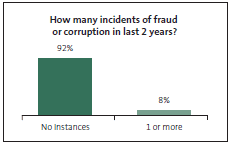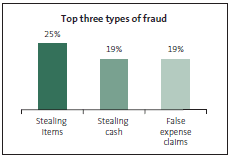Part 3: Incidents of fraud in schools

Despite our generally "clean" image, fraud is a fact of business life in New Zealand: 8% of the respondents were aware of at least one incident of fraud or corruption in their school within the last two years. This was one of the lowest rates within the public sector.
Those who knew of an incident in the last two years were asked for details of the most recent incident.
The value of the most recent fraud noted by respondents in schools was mostly low, with 92% for amounts of less than $10,000. For all public entities, 62% of the most recent frauds were for amounts less than $10,000. No school respondents identified frauds of more than $100,000. About 8% of the respondents who answered this question did not know how much money was lost.
It is not always possible to accurately establish how much money has been lost in a fraud, because sometimes the records and the investigation are incomplete.
Most of the fraud incidents in schools (75%) were committed by one internal person acting alone, typically at an operational staff level.
The most frequent types of fraud within schools were:
- theft of property, plant, and equipment or inventory (25% combined);
- theft of cash (19%); and
- fraudulent expense claims (19%).
Close monitoring of cash handling and internal controls (for property and expenses) are an important part of mitigating the risk of these types of fraud.

The most common reasons why fraud occurred was that the perpetrator did not think they would get caught (50%) and because internal controls were not followed or were overridden (28%).
Internal control systems were schools' most successful mechanism for detecting fraud, with 46% of the frauds detected in this way. Internal audit (17%) and internal tip-offs (other than through a formal whistle-blower system) identified 15% of fraud incidents.
Respondents said that none of the fraud incidents were detected by the external auditor. This is not surprising, because detecting fraud is neither the purpose nor the focus of an external audit.
Questions 32 to 40 in Appendix 1 set out the survey response data about incidents of fraud.
page top